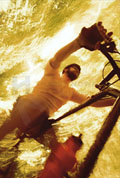Exposed! :: A little fuzzy: the importance of learning photography's fundamentals ::© Copyright 2007. All Rights Reserved. Contents A friend recently showed me a disappointing picture of his daughter in a gymnastics competition. It was a little dark and fuzzy in a non-good way. He asked, "Would this new, wide aperture, vibration reduction lens help?" Yes and no, I explained. In this edition of Exposed! we explore some finer technical points of photography and offer advice on how to maximize the use of your equipment. The Equipment PotentialFor my friend, I explained a wider aperture lens could allow more light on the sensor or film and give a brighter exposure at a set shutter speed. The new vibration reduction lenses (incorporating technology from the movie industry) can help in low light scenarios where a tripod or monopod is impossible or unwanted. However, with his existing lens, a tripod and some practice with slightly slower shutter speeds there is potential for some stunning photos. Equipment is important. Your understanding of the equipment's potential is more important. A Bit of Blur
Blur is one common element of photography that is often misunderstood. Blur is often considered to be a function of depth-of-field & focus. It can also be a function of motion. Motion blur creates excitement. Selective-focus blur accentuates the primary and/or secondary subjects. Both techniques (motion and selective focus) can intensify the potential of a photo if used well. Be aware of what you are doing! Haphazard, misplaced blur in your picture can produce muddy, fuzzy disappointments. Understanding how to create the subtle difference is important! An experienced photographer knows when and how a little blur can pump up their pictures. Equipment can help but only if you understand how to make it perform! M for MagnificentM stands for Magnificent. It also stands for Manual mode. Learning to use your camera in manual mode is akin to learning mathematics without a calculator - once you understand important relationships in math you can go on to higher concepts (with a calculator to speed things up!). Similarly, understanding the creative possibilities and inter-relationships of shutter speed, aperture & focus available in manual mode will help you get to higher levels of photography. With practice and a complete understanding of the fundamentals you can successfully jump to program modes and create consistently successful imagery instead of muddy, fuzzy disappointments. Pro PerspectiveAs a stock photographer I often have models and controlled scenarios. I have time on my side. I can, and do, take the time to shoot in manual modes. All the time. It gives me complete creative control. When I am shooting a fast-paced assignment where time and control are distant luxuries I do, sometimes, switch to auto settings. However, I know when a program mode will fail me and how to compensate for the shortfall. With knowledge of the fundamentals I can produce effectively creative blur - and other photographic wonders - in a programmed setting. HomeworkYour homework this month starts with one simple question. Have a look at the yellow bike photo above-right. It was shot with a very wide-angle lens (17mm). The camera was attached to the bicycle. I was shooting with 100 ISO at 1/15th of a second on a sunny day under some trees. (The yellow hue is caused by a film manipulation technique called "Cross Processing". It is achieved in the camera and photo lab with traditional film technology.) Question: Based on this information please answer the following: What elements of the blur are caused by motion? Answer: The blur is all from motion. With the conditions described, a relatively small aperture (big F number) would be used. Combined with the effects of using a very wide-angle lens there would be massive depth of field. If I had shot this in an automatic mode the bike photo would have been very different and likely disappointing!! Now go and get comfortable with manual mode! Auto-focus is allowed, auto programs are not! If you want better photos, more of the time consider the Creative Fundamentals Workshop. Final FrameShooting with any equipment in program mode can rob you of your creative control! Understanding the creative fundamentals of photography will help you rise above the fuzz. Take photos. Have fun! |
Samples |

